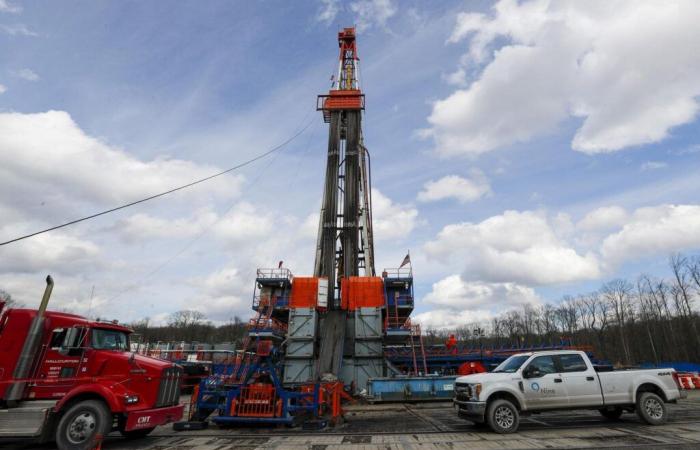Whoever wins the US presidential election, one thing will not change: the United States is expected to remain the world's largest producer of oil and gas, ahead of Saudi Arabia and Russia. Never in history have they produced so much, to the point of having become net exporters of these fossil fuels for five years.
“A lot of people in Europe don't understand the impact of what's happening there. Today, the United States has a level of hydrocarbon reserves similar to that of OPEC. explains Anna Creti, director of the chair of climate economics and the chair of gas economics at Paris Dauphine University.
The shale gas and oil revolution
In mid-October, the rate of oil extraction reached a record level of 13.4 million barrels per day, according to statistics from the US Department of Energy. That’s almost 5 million more compared to five years ago, an increase of almost 60%…
Growth is just as spectacular for gas. Until 2016, the United States did not export liquefied natural gas (LNG). They became the world's leading exporter last year, ahead of Australia and Qatar.
Hydraulic fracturing and horizontal drilling
In both cases, this result is linked to the exploitation of shale gas and oil, also called unconventional. The molecules are embedded directly in the rock rather than housed in layers. The adventure started barely twenty years ago and is linked to a double technological revolution.
First there is hydraulic fracturing, criticized by environmental defenders for the chemicals that are used, and then the development of horizontal drilling, some of which now exceed ten kilometers in length. “Hydraulic fracturing is not really debated here, even if there is some outcry,” underlines Anne-Sophie Corbeau, researcher at the Center on Global Energy Policy at Columbia University in New York.
The shale gas explosion
Between 2007 and today, annual production of shale gas (80% of American natural gas) increased from 1.3 trillion cubic meters to almost 30 trillion cubic meters. It is concentrated mainly in the Texas plains and the Appalachian basin.
With its 13,000 active wells, Pennsylvania now produces more gas than Qatar. And it is a key state in the race for the White House. This is why Kamala Harris today declares herself in favor of hydraulic fracturing, whereas in 2019, during the Democratic primary, she called for its ban.
According to experts, the Marcellus basin, which is located under Pennsylvania and West Virginia, would have enough reserves to produce until 2075 or even 2100. Without forgetting the exploitation of shale oil which also makes it possible to recover a lot of gas.
Social consensus around cheap energy
“The Americans have discovered a new resource under their feet and are not about to do without it, because in such an energy-intensive country, having cheap energy constitutes the basis of social compromise, for households as well as for businesses “, underlines Laurent Carroué, research director at the French Institute of Geopolitics (IFG). According to him, whether the winner of the presidential election is Kamala Harris or Donald Trump will have no effect on energy policy, which has allowed the United States to free itself from dependence on the resources of the Persian Gulf and the Saudi Arabia.
“If elected, the Democratic candidate should continue the support for renewable energies initiated in Joe Biden's Inflation Reduction Act (IRA), but she should not call into question the growth model based on fossil fuels, even if we are starting to see a shift in opinion on climate issues,” consider Anne of Crete
Keep gasoline prices as low as possible
But for now, keeping the price of a gallon of gasoline (3.785 liters) as low as possible is an imperative, even an obsession, for any American president. And for this we must continue to drill, as Joe Biden reminded us in 2022, by abandoning the moratorium for new hydrocarbon projects on federal lands (around 28% of the territory) which was nevertheless one of the flagship campaign promises .
“Today the bottlenecks to producing more are not linked to environmental concerns, but lie solely in the ability to produce and install enough tubes to flow the gas to the coast so that it can be exported” , recalls Laurent Carroué.
European dependence on American gas
At the start of 2024, American President Joe Biden nevertheless announced a moratorium on the construction of new LNG export terminals, citing the « menace » climate, but without calling into question the projects already launched. And there are many of them. Seven terminals are currently in service and five more are planned to see the light of day.
“Between 2022 and 2026, US LNG export capacity will grow by 60%,” recalls Olivier Appert, advisor to the Energy and Climate Center of the French Institute of International Relations (Ifri). An important point for Europe, which has already largely replaced its deliveries of Russian gas with cargoes of American gas, to the point that some see it as the replacement of one dependency by another.
Depending on the tenant of the White House, the administration could thus be more or less demanding, particularly on LNG export volumes, reserved for countries having signed a free trade agreement with the United States. There is also no question that this will increase prices for American consumers.
“If Kamala Harris is elected, she should undoubtedly also impose more restrictive standards in terms of methane emissions, linked in particular to leaks from installations, which represent the main problem,” believes Anne-Sophie Corbeau.
An asset for the competitiveness of American companies
Having abundant and cheap energy is in any case a key factor for the competitiveness of American companies. To the great dismay of Europe with which the gap is growing, to the point that entire sectors of activity are sounding the alarm. This is the case with chemistry. In France, the sector is increasing layoff plans and fears losing 15,000 jobs within three years, or 8% of its workforce.
The dropout from the sector can be explained firstly by “the cost of energy”including a price of electricity “twice higher in France than in the United States”and a gas price “five times higher”recalls Magali Smets, the general director of France Chimie.
——-






